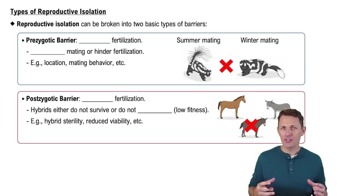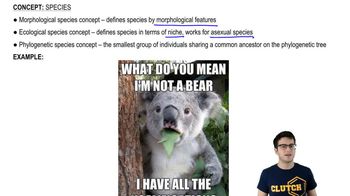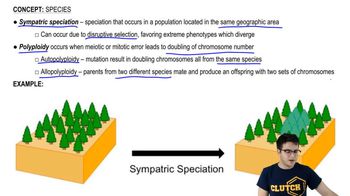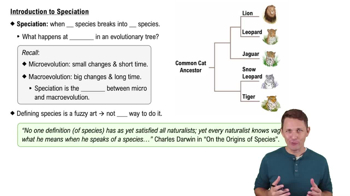Table of contents
- 1. Introduction to Biology2h 42m
- 2. Chemistry3h 40m
- 3. Water1h 26m
- 4. Biomolecules2h 23m
- 5. Cell Components2h 26m
- 6. The Membrane2h 31m
- 7. Energy and Metabolism2h 0m
- 8. Respiration2h 40m
- 9. Photosynthesis2h 49m
- 10. Cell Signaling59m
- 11. Cell Division2h 47m
- 12. Meiosis2h 0m
- 13. Mendelian Genetics4h 44m
- Introduction to Mendel's Experiments7m
- Genotype vs. Phenotype17m
- Punnett Squares13m
- Mendel's Experiments26m
- Mendel's Laws18m
- Monohybrid Crosses19m
- Test Crosses14m
- Dihybrid Crosses20m
- Punnett Square Probability26m
- Incomplete Dominance vs. Codominance20m
- Epistasis7m
- Non-Mendelian Genetics12m
- Pedigrees6m
- Autosomal Inheritance21m
- Sex-Linked Inheritance43m
- X-Inactivation9m
- 14. DNA Synthesis2h 27m
- 15. Gene Expression3h 20m
- 16. Regulation of Expression3h 31m
- Introduction to Regulation of Gene Expression13m
- Prokaryotic Gene Regulation via Operons27m
- The Lac Operon21m
- Glucose's Impact on Lac Operon25m
- The Trp Operon20m
- Review of the Lac Operon & Trp Operon11m
- Introduction to Eukaryotic Gene Regulation9m
- Eukaryotic Chromatin Modifications16m
- Eukaryotic Transcriptional Control22m
- Eukaryotic Post-Transcriptional Regulation28m
- Eukaryotic Post-Translational Regulation13m
- 17. Viruses37m
- 18. Biotechnology2h 58m
- 19. Genomics17m
- 20. Development1h 5m
- 21. Evolution3h 1m
- 22. Evolution of Populations3h 52m
- 23. Speciation1h 37m
- 24. History of Life on Earth2h 6m
- 25. Phylogeny2h 31m
- 26. Prokaryotes4h 59m
- 27. Protists1h 12m
- 28. Plants1h 22m
- 29. Fungi36m
- 30. Overview of Animals34m
- 31. Invertebrates1h 2m
- 32. Vertebrates50m
- 33. Plant Anatomy1h 3m
- 34. Vascular Plant Transport1h 2m
- 35. Soil37m
- 36. Plant Reproduction47m
- 37. Plant Sensation and Response1h 9m
- 38. Animal Form and Function1h 19m
- 39. Digestive System1h 10m
- 40. Circulatory System1h 57m
- 41. Immune System1h 12m
- 42. Osmoregulation and Excretion50m
- 43. Endocrine System1h 4m
- 44. Animal Reproduction1h 2m
- 45. Nervous System1h 55m
- 46. Sensory Systems46m
- 47. Muscle Systems23m
- 48. Ecology3h 11m
- Introduction to Ecology20m
- Biogeography14m
- Earth's Climate Patterns50m
- Introduction to Terrestrial Biomes10m
- Terrestrial Biomes: Near Equator13m
- Terrestrial Biomes: Temperate Regions10m
- Terrestrial Biomes: Northern Regions15m
- Introduction to Aquatic Biomes27m
- Freshwater Aquatic Biomes14m
- Marine Aquatic Biomes13m
- 49. Animal Behavior28m
- 50. Population Ecology3h 41m
- Introduction to Population Ecology28m
- Population Sampling Methods23m
- Life History12m
- Population Demography17m
- Factors Limiting Population Growth14m
- Introduction to Population Growth Models22m
- Linear Population Growth6m
- Exponential Population Growth29m
- Logistic Population Growth32m
- r/K Selection10m
- The Human Population22m
- 51. Community Ecology2h 46m
- Introduction to Community Ecology2m
- Introduction to Community Interactions9m
- Community Interactions: Competition (-/-)38m
- Community Interactions: Exploitation (+/-)23m
- Community Interactions: Mutualism (+/+) & Commensalism (+/0)9m
- Community Structure35m
- Community Dynamics26m
- Geographic Impact on Communities21m
- 52. Ecosystems2h 36m
- 53. Conservation Biology24m
23. Speciation
Introduction to Speciation
Problem 7`
Textbook Question
The biological definition of 'race' corresponds to all of the following except:
a. The genealogical species concept
b. The idea that subgroups within the same species can be distinguished from each other by ancestry
c. There is a natural hierarchy of groups within a species from 'lowest' to 'highest' forms
d. It should be possible to identify races on the basis of shared allele frequencies among populations
e. Races within a species are not reproductively isolated from each other.
 Verified step by step guidance
Verified step by step guidance1
Step 1: Begin by understanding the biological definition of 'race.' In biology, 'race' often refers to subpopulations within a species that share certain genetic traits or allele frequencies due to common ancestry. These groups are not reproductively isolated and can interbreed freely.
Step 2: Analyze each option provided in the question. For example, the genealogical species concept (option a) refers to defining species based on shared ancestry, which aligns with the idea of subgroups within a species.
Step 3: Consider the idea of shared allele frequencies (option d). This is a key concept in population genetics and is consistent with the biological understanding of race, as allele frequencies can vary among populations.
Step 4: Evaluate the concept of a natural hierarchy (option c). This idea is not supported by modern biology, as there is no scientific basis for ranking groups within a species as 'higher' or 'lower.' This concept is more aligned with outdated and non-scientific views.
Step 5: Confirm that races within a species are not reproductively isolated (option e). This is consistent with the biological definition, as subgroups within a species can interbreed. Based on this analysis, identify the option that does not align with the biological definition of 'race.'
 Verified video answer for a similar problem:
Verified video answer for a similar problem:This video solution was recommended by our tutors as helpful for the problem above
Video duration:
1mPlay a video:
Was this helpful?
Key Concepts
Here are the essential concepts you must grasp in order to answer the question correctly.
Genealogical Species Concept
The genealogical species concept defines a species based on the evolutionary history and lineage of organisms. It emphasizes the importance of ancestry and genetic relationships, suggesting that species are groups of organisms that share a common ancestor. This concept is crucial for understanding how races or subgroups within a species can be identified based on their genealogical ties.
Recommended video:

Biological Species Concept
Reproductive Isolation
Reproductive isolation refers to mechanisms that prevent different species or populations from interbreeding, thus maintaining distinct species. In the context of races within a species, it implies that while races may exhibit genetic differences, they are not completely isolated from one another in terms of reproduction. This concept is essential for understanding the dynamics of gene flow and genetic diversity within populations.
Recommended video:

Types of Reproductive Isolation
Allele Frequencies
Allele frequencies represent how common a particular allele is within a population. They are used to study genetic variation and can help identify subgroups or races based on shared genetic traits. Understanding allele frequencies is vital for analyzing population genetics and determining how different populations may be distinguished from one another based on their genetic makeup.
Recommended video:

Allele Frequencies

 3:03m
3:03mWatch next
Master Introduction to Speciation with a bite sized video explanation from Jason
Start learningRelated Videos
Related Practice


















